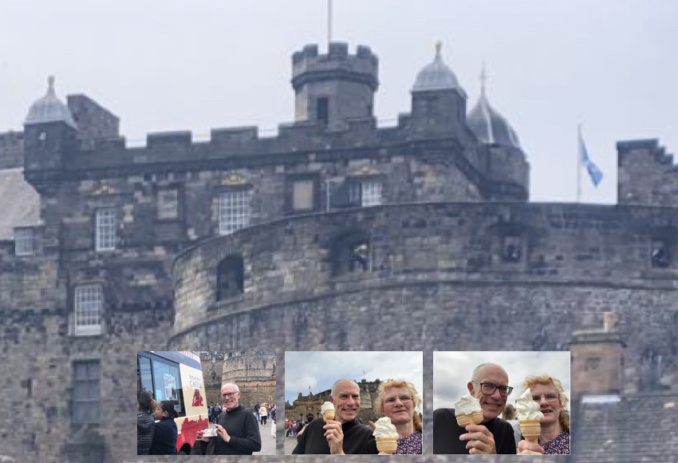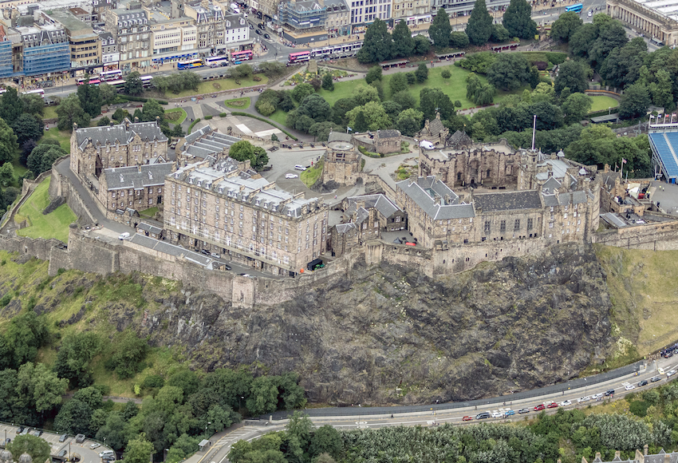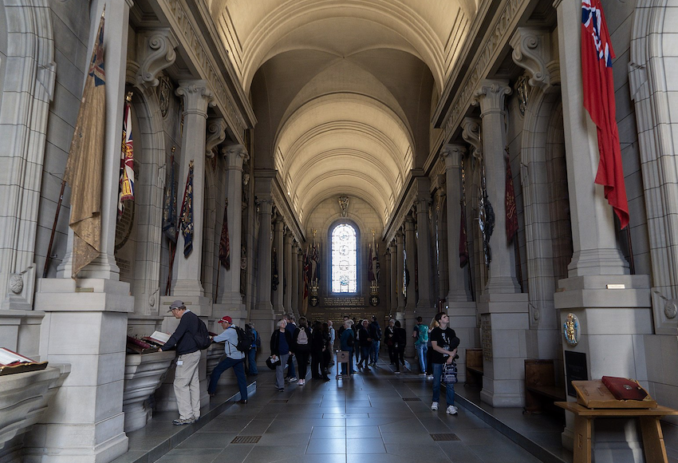Mrs AWS and I are enjoying our day trip to Edinburgh. Although we’re used to exploring Princes Street, this time we are swept in a crowd of alighting passengers at Edinburgh’s Waverley station in the direction of the Royal Mile. In previous episodes, we enjoyed Holyroodhouse Palace (and the neighbouring King’s Gallery), the Holyrood parliament of the Scottish government (and its attendant expel-the-Jews peace camp), and a McCook’s tour of Scottish Reformation Kirks. This time, we have reached the top of a castle hill packed with tourists.
On a warm May day following a precise mile’s climb from Holyroodhouse Palace gatehouse to Edinburgh Castle gatehouse – and not being the Great Man I once was – I feel as though I’m about to die of heat stroke. Salvation is at hand. Regular readers will recall my work colleagues pay me not to attend the office Christmas party. A crisp (Scottish) ten-pound note has slept in my wallet since the middle of December. If you find this crafted prose tiresome, imagine having to listen to me. On a dark night. When I’ve been drinking. Indeed.
As an example of the bantz, I must tell you this. The Gods of Retail dictate we’re open until the middle of the night. At times, it goes quiet, and the youngsters’ morale drops. Not to worry, it falls upon the older members of staff to think of ways to keep them occupied. Which is why, one full moon, a steam engine competition took place along the dog food aisle. The chuff-chuff sound had to be precise and in proportion to the speed of your movement: accurate to starting, accelerating, maintaining speed, coasting, slowing, and then breaking.
One of the young ladies showed a talent for such things. A nippy runner and an accomplished mimic, all girl-hell broke out when I disqualified her. You see, as if the most out of control, out-of-balance puffing Billy on a neglected Congo branch line (decades after the engineers returned to Belgium with the sweat-stained ‘Handboek voor Machinisten van de Stoomlocomotief van de Spoorwegen’), she moved her arm-pistons in parallel rather than antagonistic to each other. Tut tut.
If that’s a quiet summer’s night when all the bargain hunters are at home watching a WendyBall match, you can imagine what a Christmas party might be like. Keep well away. Back on our outing, my ten-pound note awakens and prods me towards an ice cream van standing before the cranes rearranging the esplanade in anticipation of the military tattoo.

© Always Worth Saying 2024, Going Postal
So expensive there wasn’t a queue, in the symmetry connecting sad men, long-suffering wives and shop girls at yuletide festivities, two 99s touched the full ten pounds. And they were delicious. Despite it only being two o’clock, it was now close to the departure time of our return train. We can’t afford ice cream and peak-time travel.
Lingering about a parapet while walloping down our ices, we observed the city and distant volcanic hills while demolishing our treats and pondered the passage of time. In the bat of an eyelid, the handsome young man who once strode the world and the girl with the flowing titian hair and impossibly short skirts have turned into their grandparents. Twas ever so. As for the centuries Edinburgh Castle has endured:
Edinburgh Castle
This historic fortress, dominating the skyline of the capital of Scotland, stands atop Castle Rock, a volcanic plug formed about 350 million years ago. Archaeological evidence suggests human occupation dating back to the Iron Age, around the 2nd century AD, when likely a hill fort. The castle’s recorded history, however, begins in the early Middle Ages.
The first documented reference to a fortification on this site dates to the 12th century, during the reign of King David I, who established Edinburgh as one of Scotland’s principal royal residences. The castle served as a royal treasury and an administrative hub, and its strategic location made it a key defensive stronghold in Scotland’s wars of independence against England.
In 1296, Edward I of England, Langshanks, the Hammer of the Scots, captured Edinburgh Castle, marking the beginning of a turbulent contest for control between Scot’s and English forces. The castle changed hands several times during the Wars of Scottish Independence, with notable sieges including those led by Robert the Bruce. In 1314, Thomas Randolph, a lieutenant of Bruce, recaptured the castle in a daring night raid.
Between the 14th and 15th centuries, the defences became more fortified. Notable developments included David II’s construction of David’s Tower in the 1370s. This massive structure was part destroyed during the Lang Siege (1571-1573) when supporters of Mary, Queen of Scots, held the castle against the forces of the Regent, the Earl of Morton.
The Renaissance period brought further changes, with James IV constructing the Great Hall in the first part of the 16th century and James V adding the Royal Palace and the Half Moon Battery. These enhancements solidified the castle’s role as a fortress and a royal residence and administrative centre.

Aerial Edinburgh Castle,
Godot13 – Licence CC BY-SA 4.0
Edinburgh Castle played a significant role during the Jacobite Risings in the 17th and 18th centuries, although never captured by Jacobite forces. The last significant action occurred in 1745 during the final Jacobite Rising, led by Bonnie Prince Charlie. After the defeat of the Jacobites, the castle’s military significance diminished.
In the 19th century, the castle began to assume more of its current role as a national monument and tourist attraction. Significant restorations and reconstructions were undertaken, and the castle opened to the public. The crown jewels of Scotland, known as the Honours of Scotland, and the Stone of Destiny, used in the coronation of Scottish monarchs, are displayed in the Crown Room.
Today, Edinburgh Castle is one of Scotland’s most iconic landmarks and a major tourist destination, attracting millions of visitors each year. It also serves ceremonial and cultural functions, including the annual Royal Edinburgh Military Tattoo, which takes place in August. On a previous trip, I was attracted to a war memorial within the walls.
The Scottish National War Memorial
Conceived in the aftermath of World War I, the memorial was established to honour the Scottish soldiers who lost their lives in the devastating conflict. The initiative for the memorial being driven by a profound national desire to create a lasting tribute to the fallen.
The distinguished architect Sir Robert Lorimer, who led the project from 1923 to 1927, designed and constructed the memorial. Edward, Prince of Wales, who would later become King Edward VIII, dedicated the memorial on July 14, 1927. This solemn ceremony marked the culmination of years of planning and building, resulting in a structure combining Gothic Revival and Scottish Baronial architectural elements.

Edinburgh Castle,
Paul Hudson – Licence CC BY-SA 2.0
Situated on the north side of Crown Square, the memorial occupies a former barrack block. Its interior is a showcase of rich decoration, featuring an array of sculptures, stained glass, and intricate carvings. The central Hall of Honour serves as the focal point, where the names of the fallen are inscribed in illuminated books. These Rolls of Honour list over 147,000 Scots who perished in World War I, World War II, and subsequent conflicts.
Each area within the memorial is dedicated to various Scottish regiments, adorned with their colours and unique memorials. Among the symbolic elements is the Stone of Remembrance, positioned in the centre and bearing the inscription “To the Glory of God and in Memory of the Scottish Soldiers who Fell in the Great Wars.”
The memorial also features evocative sculptures by renowned Scottish artists such as Pilkington Jackson and Alexander Carrick, which portray the many facets of military life and sacrifice. Stained glass windows designed by artists like Douglas Strachan further enrich the interior, depicting themes of courage, sacrifice, and peace.
Beyond its architectural and artistic significance, the Scottish National War Memorial holds immense national importance. It stands as a poignant reminder of the sacrifices made by Scottish servicemen and women, serving as the focal point for national remembrance and ceremonies, particularly on Armistice Day. The memorial plays an educational role, providing visitors with insights into Scotland’s military history and the profound impact of the world wars on the country.
During a previous visit, some old newspaper cuttings caught the eye and, on the rail journey back to England, provided a poignant reminder of tragedy far from the battlefield.
To be continued…
© Always Worth Saying 2024



